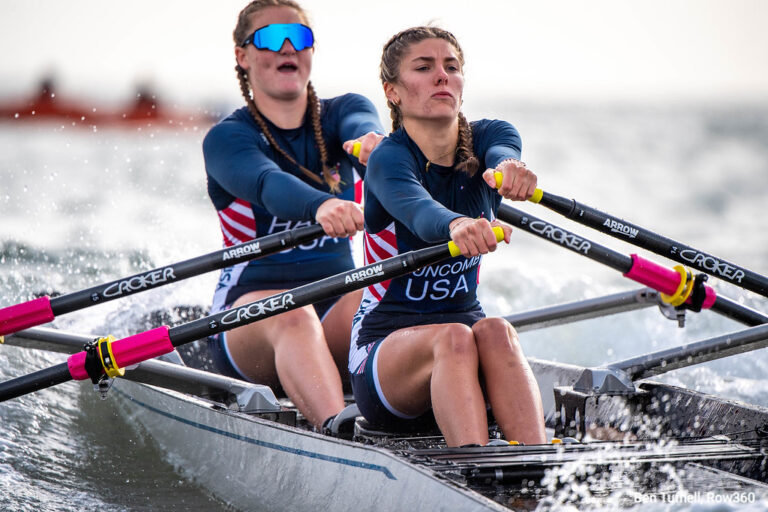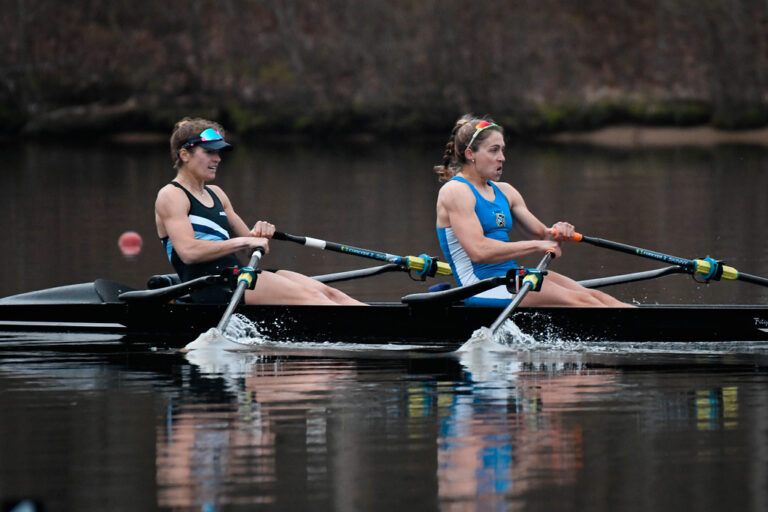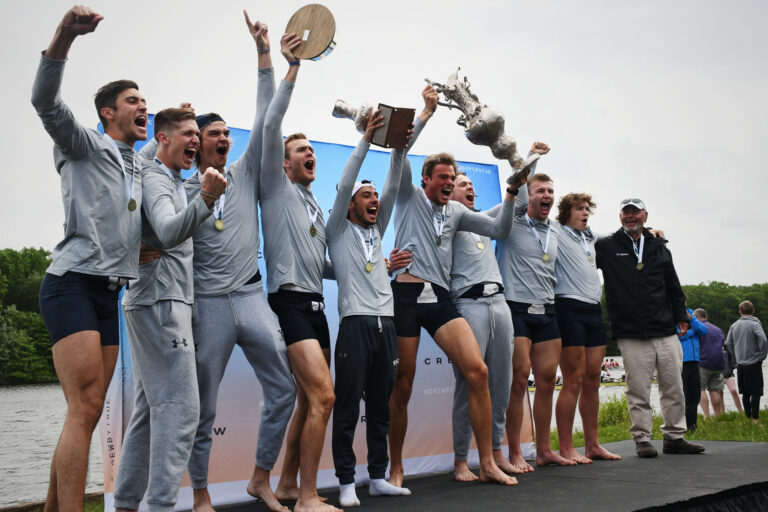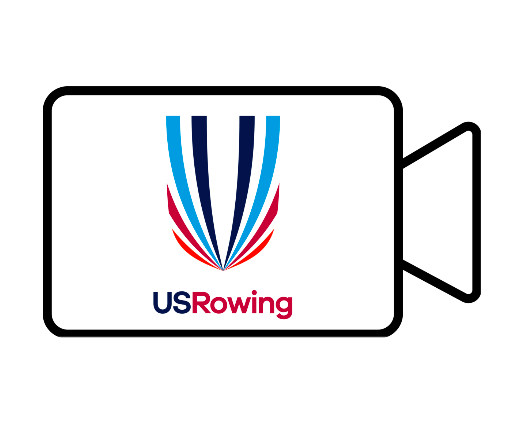STAGE 4 - Perform, Excel
Chronological Age: 17+
Target Audience: Competitive High School Senior, Collegiate, Post-Collegiate High-Performance Masters
Stage 4 rowers have chosen to train and compete in a high performance environment, where the goal is to succeed at the highest competitive levels of rowing.
Rowers can begin Stage 4 as early as age 17 if they are a high school junior or senior and have a significant rowing training base. High performance environments include collegiate programs, post-collegiate training centers, and Under 23, National, and Olympic teams. Collegiate walk-ons or post-collegiate rowers may begin in Stage 4, depending on the background of the athlete.
Early Stage 4 training includes High Performance teams/camps for youth athletes and NCAA (or equivalent) for adults. Training loads for these athletes are periodized annually at an intensity that would not be suitable for the majority of rowers in their respective age groups. Early Stage 4 is often the first experience athletes have with training at a high level. As a result, coaches should ensure athletes have no gaps in their performance curriculum to create a supportive and safe environment.
Concepts

MAXIMIZE ATHLETIC POTENTIAL
The Stage 4 rower is focused on maximizing rowing performance. A rower who is not invested in rowing performance should go to Stage 5 “Row for Life”, instead of Stage 4 “Perform and Excel.”

COMMIT TO A LONG TERM TRAINING PROGRAM
The Stage 4 rower should have a training plan that builds individual sessions into weeks, weeks into months, months into seasons, seasons into years, and years into long-term development. This training plan should include rowing training, other forms of aerobic development, strength training, and other forms of physical training. Balancing other life’s responsibilities, such as family, school, and employment, is also important to maintain.
Foundations
MAXIMIZE TALENTS
The goal of the Stage 4 rower is to compete to the best of their athletic potential.
CREATE FULL-YEAR PLAN TO PROGRESS
Coaches must periodize their training plan to selectively build specific athletic qualities while maintaining others. The diverse athletic demands of the 2000 meter race require varying times for peak performance training of these skills. Coaches must guide Stage 4 rowers through a year-round development program to maximize performance and reduce risk of overtraining, injuries, and burnout.
Rowers and coaches need to be particularly aware of the return-to-training phase as a sensitive window of increased injury risk. In order to avoid injury, training volume and/or intensity should be reduced to accommodate re-adaptation.
Read more here about the return-to-training phase.
Stage 4 rowers should be familiar with a three-zone training intensity distribution model but will likely use a five-zone model or more, depending on how much detail the coach desires. USRowing uses a six-zone model with more information available on page 123 (Module 6, Topic 2: “Training Methods for Aerobic Fitness”) of the Level 2 manual.
FOCUS ON HIGH-PERFORMANCE
The Stage 4 rower focuses on competing at the highest levels of the sport. For rowers aged 17-18, these opportunities include: USRowing regionals, USRowing nationals, college recruitment, and potentially development camps and extracurricular rowing opportunities (e.g. Youth Development Camp, Selection Development Camp, under 19 National Team).
The collegiate rower is focused on performing at key competitions (i.e., ACRA, NCAA, or IRA national championships), and may elect to pursue extracurricular rowing opportunities (i.e., World University Games and under 23 rowing).
Post-collegiate high-performance rowers pursue under 23 and national team selection.
OFFER COMPETITIONS COMMENSURATE WITH ATHLETE SKILL LEVEL
Coaches should be versed in the most recent high-performance pathways and prepared to guide Level 4 rowers through increasing levels of selection commensurate with their skill and ability. Rowers may pursue competitive opportunities listed above, as well as additional races such as the Head of the Charles and ergometer racing, if the coach determines it is beneficial for their development.
COMPETE AT ELITE NATIONAL AND INTERNATIONAL COMPETITIONS
Stage 4 rowers may compete beyond the local or regional level to challenge themselves against the best rowers at the national and international level. Coaches should guide competitive selection and goals for each race to motivate the athletes and encourage a stronger connection to the sport and competitors.
Stage 4 rowers may move to Stage 5 as a mentor (coach, official, etc.) or masters rower. USRowing recognizes how much value former collegiate and high performance rowers can continue to bring to the sport and encourages them to find ways to stay involved in and out of the boat.
Foundations
MAXIMIZE TALENTS
The goal of the Stage 4 rower is to compete to the best of their athletic potential.
CREATE FULL-YEAR PLAN TO PROGRESS
Coaches must periodize their training plan to selectively build specific athletic qualities while maintaining others. The diverse athletic demands of the 2000 meter race require varying times for peak performance training of these skills. Coaches must guide Stage 4 rowers through a year-round development program to maximize performance and reduce risk of overtraining, injuries, and burnout.
Rowers and coaches need to be particularly aware of the return-to-training phase as a sensitive window of increased injury risk. In order to avoid injury, training volume and/or intensity should be reduced to accommodate re-adaptation.
Read more here about the return-to-training phase.
Stage 4 rowers should be familiar with a three-zone training intensity distribution model but will likely use a five-zone model or more, depending on how much detail the coach desires. USRowing uses a six-zone model with more information available on page 123 (Module 6, Topic 2: “Training Methods for Aerobic Fitness”) of the Level 2 manual.
FOCUS ON HIGH-PERFORMANCE
The Stage 4 rower focuses on competing at the highest levels of the sport. For rowers aged 17-18, these opportunities include USRowing regionals, USRowing nationals, college recruitment, and potentially development camps and extracurricular rowing opportunities (e.g. Youth Development Camp, Selection Development Camp, Under 19 national team).
The collegiate rower is focused on performing at key competitions (i.e., ACRA, NCAA, or IRA national championships), and may elect to pursue extracurricular rowing opportunities (i.e., World University Games and under 23 rowing).
Post-collegiate high-performance rowers pursue under 23 and national team selection.
OFFER COMPETITIONS COMMENSURATE WITH ATHLETE SKILL LEVEL
Coaches should be versed in the most recent high-performance pathways and prepared to guide Level 4 rowers through increasing levels of selection commensurate with their skill and ability. Rowers may pursue competitive opportunities listed above, as well as additional races such as the Head of the Charles and ergometer racing, if the coach determines it is beneficial for their development.
COMPETE AT ELITE NATIONAL AND INTERNATIONAL COMPETITIONS
Stage 4 rowers may compete beyond the local or regional level to challenge themselves against the best rowers at the national and international level. Coaches should guide competitive selection and goals for each race to motivate the athletes and encourage a stronger connection to the sport and competitors.
The goal of strength training for Stage 4 rowers is to maximize their competitive ability and reduce risk of rowing injuries. Improving performance and reducing injuries go hand-in-hand, as Stage 4 rowers need to remain healthy to complete the high volume of training required for technical, physiological, and competitive improvements. Different Stage 4 rowers will need different things from strength training depending on their prior development and major training goals. Coaches should be prepared and qualified to guide and instruct physical development through individualized, year-round strength training, or hire a strength coach.
Stage 4 rowers may move to Stage 5 as a mentor (coach, official, etc.) or masters rower. USRowing recognizes how much value former collegiate and high-performance rowers can continue to bring to the sport and encourages them to find ways to stay involved in and out of the boat.

